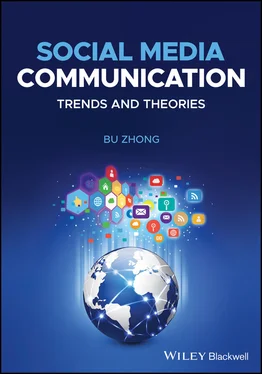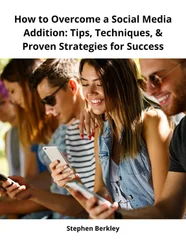The first half of the book provides a multidisciplinary examination of the social media mechanism by drawing on the latest research findings in communication studies, information sciences, neurosciences, psychology and sociology. The impact of social media on information processing, social networking, cognition, media industry, and business marketing will be thoroughly discussed in this part. A solid knowledge of the social media mechanism should serve readers well in making the best use of them no matter how social media might evolve, or what new platforms could emerge in the future.
The second half of the book is devoted to research-based strategies regarding how to use social media productively in communication and business settings. Designed as a principal textbook for undergraduate and graduate-level courses in schools of communications and business, this book constitutes original research findings in all its chapters, including those from the author and his colleagues. Specifically, this book has the following major features:
1 The Underlying Mechanism. This is not just another “how-to” book concerning social media use or their marketing potential. Rather, it provides an in-depth understanding of the mechanism underlying social media and their implications in various communication settings. This approach should help readers to make the best use of social media tools while recognizing the individual, group, and cultural differences involved. The latter often plays a pivotal role in global communication and business practices.
2 A Multidisciplinary Approach. The book employs a multidisciplinary approach to study social media and their impacts by drawing on the latest research findings in communication studies, neuroscience, information science, and psychology. The approach should be able to empower those who have an interest in doing more research in this stream. Though this part is mainly designed for graduate students and researchers, it provides answers to anyone who likes to explore “why so” in using social media tools.
3 Theory Highlights. Over a dozen of theories in the areas of communication, psychology, and sociology will be introduced. The goal is to enable readers to be acquainted with the theoretical frameworks researchers frequently employ in their social media studies. After reading the theory highlights, readers should have a good grasp of what each of the theories is about. The highlights also serve as a springboard for anyone who would like to explore more theories of interest in studying the impact of social media.
Most of the content in this book is based on the author’s research and teaching in social media at a US university in recent years. The author has designed and taught several social media courses for undergraduate and graduate students at The Pennsylvania State University and Hong Kong Baptist University. The four courses are: “Social Media for Social Change,” “Social Media Research: Trends and Theories,” “Social Media Communication,” and “Social Media Marketing,” all of which had never been taught at the two universities before, and were well received by the students who majored in communication, psychology, business, and information science and technology.
In addition to college students, this book should be a tremendous source for researchers, educators, journalists, small business owners, librarians, and practitioners in media management, advertising, public relations, and business marketing. This book, however, does not have all of the answers for social media. It is understandable that some readers wish for a book that provides all of the answers and dictates their learning about social media. Most readers still want to search out materials and answers of their own. In the latter case, the current book serves as a critical source for starting a journey to a better understanding of digital media technology and how it transforms social interaction. As media theorist Neil Postman said, “Technology doesn’t just add something, it changes everything,” though new technology can never substitute for human values (Hendrickson, 2000).
This book thus aims to provide its readers with an in-depth understanding of the social media mechanism, on which they may develop strategies in connecting with others and cope with the communication challenges in a networked society. The information benefits are manifold, including not only staying away from social pain, but also joining hands to change the world. If you care about the impact of social media – what social media usage reveals about us, what it is delivering and we fantasize it can supply, this book is for you.
1 Almehmadi, A., Bourque, M., & El-Khatib, K. (2013). A Tweet of the mind: Automated emotion detection for social media using brainwave pattern analysis. The 2013 International Conference on Social Computing, Alexandria, VA.
2 Baumeister, R. F., & Leary, M. R. (1995). The need to belong: Desire for interpersonal attachments as a fundamental human motivation. Psychological Bulletin, 117(3), 497–529. https://doi.org/.10.1037/0033-2909.117.3.497
3 Hendrickson, L. (2000). Communications technology and personal identity formation. Educational Technology & Society, 3(3), 27–38. https://www.jstor.org/stable/pdf/jeductechsoci.3.3.27.pdf?refreqid=excelsior%3A5ae5dcab75c12af810fa8ce76b5be48e.
4 Lieberman, M. D. (2013). Social: Why our brains are wired to connect. Crown Publishers.
5 Rheingold, H. (2012). Net smart: How to thrive online. The MIT Press.
6 Stafford, T., & Bell, V. (2012). Brain network: Social media and the cognitive scientist. TRENDS in Cognitive Science, 16(10), 489–490. https://doi.org/10.1016/j.tics.2012.08.001.
7 Viale, R. (2011). Brain reading social action. International Review of Economics, 58(3), 319–366. https://doi.org/10.1007/s12232-011-0130-0.
Part I Theoretical Foundation of Social Media Use
1 Why Study Social Media?
LEARNING GOALS
This chapter will help you understand:
What is the power of social media?
Are social media the culprit of causing social distrust?
Why do we need to study social media?
How are traditional and digital media technology adopted differently?
KEY CONCEPTS
The “Us vs. Them” mentality
Echo chamber
Digitization
Silo effect
Information cocoon
Digitalization
THEORY HIGHLIGHT
Construal Level Theory
Even though Joe Biden won the United States presidency in 2020, Democrats in the House of Representatives suffered serious defeats in the election, falling far short of expectations and setting off infighting amongst themselves. Immediately after Election Day, some Democratic House members pointed fingers at colleagues for losing seats in the House of Representatives. One of their key concerns was lack of appreciation of the importance of social media strategies in political campaigns. No one argued about whether to incorporate social media into campaign strategies or not. Rather, they debated the consequences of failing to let social media play an important role in the political activities.
The Power of Social Media
Congresswoman Alexandria Ocasio-Cortez said that it was inadequate for her Democratic colleague, Conor Lamb, to spend merely $2,000 on Facebook the week before the election, although he did manage to win in Pennsylvania (Herndon, 2020). “If you’re not spending $200,000 on Facebook with fund-raising, persuasion, volunteer recruitment, get-out-the-vote the week before the election, you are not firing on all cylinders,” said Ocasio-Cortez (Herndon, 2020). To her, digital investment and advertising on Facebook was important because that’s where voters gathered, and both positive and negative political rhetoric went viral all the time. In political campaigns, no one could afford to allow Facebook to radicalize things without fighting back, she said (Herndon, 2020).
Читать дальше












